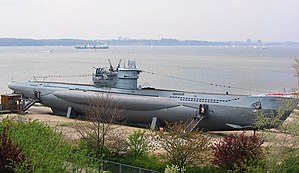German submarine U-1020
 U-995 Type VIIC/41 at the Laboe Naval Memorial. This U-boat is almost identical to U-1020.
| |
| History | |
|---|---|
| Name | U-1020 |
| Ordered | 13 June 1942 |
| Builder | Blohm & Voss, Hamburg |
| Yard number | 220 |
| Laid down | 30 April 1943 |
| Launched | 22 March 1944 |
| Commissioned | 17 May 1944 |
| Fate | Sunk on or after 9 January 1945 |
| General characteristics | |
| Type | Type VIIC/41 submarine |
| Displacement | |
| Length |
|
| Beam |
|
| Height | 9.60 m (31 ft 6 in) |
| Draught | 4.74 m (15 ft 7 in) |
| Installed power |
|
| Propulsion |
|
| Speed |
|
| Range | |
| Test depth |
|
| Complement | 44-52 officers & ratings |
| Armament |
|
| Service record | |
| Part of: |
|
| Identification codes: | M 22 946 |
| Commanders: |
|
| Operations: |
|
| Victories: | None |
German submarine U-1020 was a
.She was ordered on 13 June 1942, and was
Design
The submarine had a maximum surface speed of 17.7 knots (32.8 km/h; 20.4 mph) and a maximum submerged speed of 7.6 knots (14.1 km/h; 8.7 mph). When submerged, the boat could operate for 80 nautical miles (150 km; 92 mi) at 4 knots (7.4 km/h; 4.6 mph); when surfaced, she could travel 8,500 nautical miles (15,700 km; 9,800 mi) at 10 knots (19 km/h; 12 mph). U-1020 was fitted with five 53.3 cm (21 in)
Service history
U-1020 had a
On 22 November 1944, U-1020 left Horten on her first, and only, war patrol. Forty-nine days into her patrol, 9 January 1945, U-1020 struck a British mine east of Dundee in the North Sea. All 52 of her crew went down with the boat.[2]
The wreck now lies at 56°32′7″N 01°18′7″W / 56.53528°N 1.30194°W.[2]
See also
References
- ^ Helgason, Guðmundur. "Otto Eberlein". German U-boats of WWII - uboat.net. Retrieved 24 March 2016.
- ^ a b c d Helgason, Guðmundur. "U-1020". German U-boats of WWII - uboat.net. Retrieved 24 March 2016.
- ^ a b Gröner 1991, pp. 43–44.
Bibliography
- Busch, Rainer; Röll, Hans-Joachim (1999). German U-boat commanders of World War II : a biographical dictionary. Translated by Brooks, Geoffrey. London, Annapolis, Md: Greenhill Books, Naval Institute Press. ISBN 1-55750-186-6.
- Busch, Rainer; Röll, Hans-Joachim (1999). Deutsche U-Boot-Verluste von September 1939 bis Mai 1945 [German U-boat losses from September 1939 to May 1945]. Der U-Boot-Krieg (in German). Vol. IV. Hamburg, Berlin, Bonn: Mittler. ISBN 3-8132-0514-2.
- Gröner, Erich; Jung, Dieter; Maass, Martin (1991). German Warships 1815–1945, U-boats and Mine Warfare Vessels. Vol. 2. Translated by Thomas, Keith; Magowan, Rachel. London: Conway Maritime Press. ISBN 0-85177-593-4.
External links
- Helgason, Guðmundur. "Patrols by U-1020". German U-boats of WWII - uboat.net.
